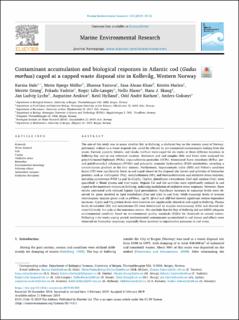Contaminant accumulation and biological responses in Atlantic cod (Gadus morhua) caged at a capped waste disposal site in Kollevåg, Western Norway
Dale, Karina; Müller, Mette Bjørge; Tairova, Zhanna; Khan, Essa Ahsan; Hatlen, Kristin; Grung, Merete; Yadetie, Fekadu; Lille-Langøy, Roger; Blaser, Nello; Skaug, Hans J; Lyche, Jan Ludvig; Arukwe, Augustine; Hylland, Ketil; Karlsen, Odd André; Goksøyr, Anders
Peer reviewed, Journal article
Published version
Permanent lenke
https://hdl.handle.net/11250/2644117Utgivelsesdato
2019Metadata
Vis full innførselSamlinger
Sammendrag
The aim of this study was to assess whether fish in Kollevåg, a sheltered bay on the western coast of Norway, previously utilized as a waste disposal site, could be affected by environmental contaminants leaking from the waste. Farmed, juvenile Atlantic cod (Gadus morhua) were caged for six weeks at three different locations in Kollevåg bay and at one reference location. Sediments and cod samples (bile and liver) were analyzed for polychlorinated biphenyls (PCBs), organochlorine pesticides (OCPs), brominated flame retardants (BFRs), per-and polyfluoroalkyl substances (PFASs) and polycyclic aromatic hydrocarbon (PAH) metabolites, revealing a contamination gradient at the four stations. Furthermore, hepatosomatic index (HSI) and Fulton's condition factor (CF) were significantly lower in cod caged closest to the disposal site. Levels and activities of biomarker proteins, such as vitellogenin (Vtg), metallothionein (Mt), and biotransformation and oxidative stress enzymes, including cytochrome P450 1a and 3a (Cyp1a, Cyp3a), glutathione s-transferase (Gst) and catalase (Cat), were quantified in blood plasma and liver tissue. Hepatic Cat and Gst activities were significantly reduced in cod caged at the innermost stations in Kollevåg, indicating modulation of oxidative stress responses. However, these results contrasted with reduced hepatic lipid peroxidation. Significant increases in transcript levels were observed for genes involved in lipid metabolism (fasn and acly) in cod liver, while transcript levels of ovarian steroidogenic enzyme genes such as p450scc, cyp19, 3β-hsd and 20β-hsd showed significant station-dependent increases. Cyp1a and Vtg protein levels were however not significantly altered in cod caged in Kollevåg. Plasma levels of estradiol (E2) and testosterone (T) were determined by enzyme immunoassay (EIA) and showed elevated E2 levels, but only at the innermost station. We conclude that the bay of Kollevåg did not fullfill adequate environmental condition based on environmental quality standards (EQSs) for chemicals in coastal waters. Following a six weeks caging period, environmental contaminants accumulated in cod tissues and effects were observed on biomarker responses, especially those involved in reproductive processes in cod ovary.
